As a non-fiction geek I have to admit — insert eye roll here, if you’d like — that I really, truly, loved reading the books I’ve recommended lately. I know they were intense: serious Christian engagement with the ethos of modern art, Biblical insight about racial inequality, Bob Goudzwaard & Craig Bartholomew deconstructing the entire Western culture. Even John Van Sloten’s delightfully inspiring book about finding God in the work-world that is upbeat and unexpected, enters an exceptionally serious subject: spiritual formation and whole-life discipleship as it relates to the vocation and calling and our often difficult jobs. I know these aren’t simple books, but I just loved turning the pages, learning, being inspired to think. It is part of my job to tell others about them, making a case that this sort of book should be bought and studied and talked about. Granted, sometimes these books are slow-going, but the rewards are notable.
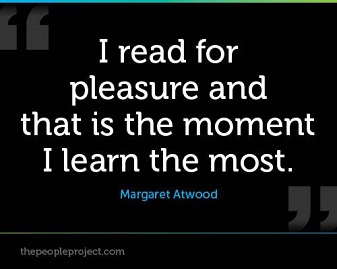
And yet I also need books (and TV shows and CDs) that are taken up for the sheer pleasure of it, books that are chosen not primarily to learn or study or engage or find God or serve the common good, but because they provide just old fashioned, good-old entertainment.
Novels come to mind, obviously, so I’m going to skip suggesting those for now.
Rather, here are nonfiction books that you might enjoy on these summery days. Maybe you get some vacation (I know, some of us don’t) but I suspect your schedule and lifestyle feels a little different in these new few months. Here are some convivial books that we think you might get a real kick out of. Oh, and by the way: you’ll learn something too. A few might even be transformational. What a bargain!
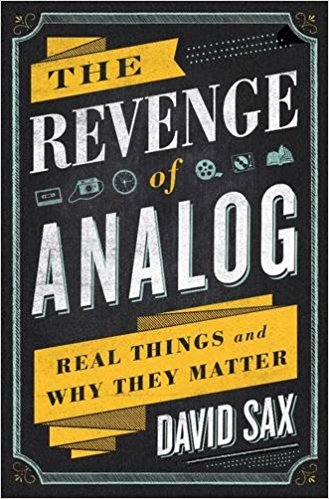 Revenge of Analog: Real Things and Why They Matter David Sax (Public Affairs) $25.99 Oh man, what a book. From the first chapter about a new record store (that’s real records, a store selling vinyl, like I used to in the early 70s in the Platter Palace shops in Hanover and Gettysburg) that opened in his Toronto neighbor, I was hooked, absolutely hooked. Sax visits the manufacturing plants that make vinyl, discusses the rise of the sales of record players, and weighs in on why the listening experience via vinyl is superior. (I almost cried when he explained how, despite his own huge digital music library he just doesn’t listen to music much anymore; there are too many choices, too much to dip in to, and it can be so incidental. Selecting an album, among a limited selection, and putting it on carefully, brings an full-orbed intentionality, and something deep within me resonated.)
Revenge of Analog: Real Things and Why They Matter David Sax (Public Affairs) $25.99 Oh man, what a book. From the first chapter about a new record store (that’s real records, a store selling vinyl, like I used to in the early 70s in the Platter Palace shops in Hanover and Gettysburg) that opened in his Toronto neighbor, I was hooked, absolutely hooked. Sax visits the manufacturing plants that make vinyl, discusses the rise of the sales of record players, and weighs in on why the listening experience via vinyl is superior. (I almost cried when he explained how, despite his own huge digital music library he just doesn’t listen to music much anymore; there are too many choices, too much to dip in to, and it can be so incidental. Selecting an album, among a limited selection, and putting it on carefully, brings an full-orbed intentionality, and something deep within me resonated.)
In other chapters Sax uses the creative nonfiction styles of memoir and sociology, reporting and interviews, to weave a narrative that moves from the Moleskine plant in Italy (in a fascinating chapter called “The Revenge of Paper”) to a fabulous chapter on schools and the debate about the over-use of digital technologies in education.
If you love bookstores you will love the chapter called “The Revenge of Retail” as he walks us through several small shops, critiques the ubiquity of Amazon, and listens in to readers as they talk about their Kindles. Is there a way to humanize and make more really real the e-commerce experience? (We try, here, which is why I always reply to our on-line orders with a personal email.) There is a really great chapter in Revenge of… on board games (which, if you are youngish, you know are on the rise) and a great chapter on film, where the shift to digital was swift and decisive; but guess what? There is a chapter called “The Revenge of Work” and the book ends (I skipped ahead) with an epilogue called “The End of Summer.” This is happy, narrative non-fiction at its best, interesting and informative and at times exciting.
Two years ago we reviewed at Booknotes and promoted a book about basic Christian living that explored artisan and maker culture called Jesus Bread and Chocolate: Crafting a Handmaid Faith in a Mass-Market World by indie rock reviewer, musician, bread-maker and craft beer aficionado John J. Thompson (Zondervan; $15.99.) A number of our customers continue to tell us how much they enjoyed it; well, if you liked that one, you’ll really appreciate this.
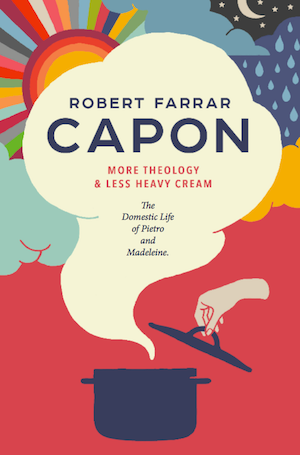 More Theology and Less Heavy Cream: The Domestic Life of Pietro and Madeleine Robert Farrar Capon (Mockingbird) $16.00 Okay, I can’t review this thoroughly now, but will just set it up for you. It’s more or less a follow up to a nonfiction book, so although it isn’t non-fiction, I’m listing it here now. I hope you know the award-winning, wonderfully written and rather intense theological cookbook by Capon called Supper of the Lamb: A Culinary Reflection (Moder Library; $16.00.) It is exactly that, a memoir about cooking, including a large leg of lamb recipe, by theologian and Episcopal priest, the late Fr. Robert Farrar Capon.
More Theology and Less Heavy Cream: The Domestic Life of Pietro and Madeleine Robert Farrar Capon (Mockingbird) $16.00 Okay, I can’t review this thoroughly now, but will just set it up for you. It’s more or less a follow up to a nonfiction book, so although it isn’t non-fiction, I’m listing it here now. I hope you know the award-winning, wonderfully written and rather intense theological cookbook by Capon called Supper of the Lamb: A Culinary Reflection (Moder Library; $16.00.) It is exactly that, a memoir about cooking, including a large leg of lamb recipe, by theologian and Episcopal priest, the late Fr. Robert Farrar Capon.
(To appreciate the impact a book like that can have, read the breathtakingly good chapter “And She Took Flour: Cooking Lessons from Supper of the Lamb” by our friend Denise Frame Harlan, in the spectacular collection of essays The Spirit of Food: Essays on Food and Faith edited by Leslie Leyland Fields [Wipf & Stock; $32.00] which is one of my all time favorite books.)
You might know that alongside the food writing for the New York Times and the aforementioned classic Supper of the Lamb, Capon wrote a novel or two, several works of Biblical studies, and a handful of very interesting theology books. Only his best fans, though, know that Cowley Press released, with a woefully silly cover that did not do the book justice, a collection of fictional conversations between Pietro and Madleine that originally had been published in the wickedly funny and now folded Christian satire mag The Wittenburg Door. (Yes, yes, it was misspelled.) That book remains in print and is called Light Theology and Heavy Cream: The Culinary Adventures of Pietro and Madeline. At this point it is helpful to know that the blowhard Pietro was Fr. Capon’s alter ego and Madeleine was his wife, Valeria Capon. More Theology and Less Heavy Cream is, in fact – drum roll please – a collection of never-before-published essays featuring the two colorful characters, at it again. As it says on the back cover, “Armed only with oven mitts and a razor-sharp wit, this unforgettable couple spars over God, food, grace, and everything in between.” Kudos to Mockingbird for bringing this into print. And, speaking of kudos, we can thank them for bringing out in a slim colorful paperback, the rare Capon novel, The Man Who Met God in a Bar: The Gospel According to Marvin. We’ve got it in stock now, but we’ll tell you more about it when we list some fiction favorites, soon. For now, know of this hilarious newly released, grace-filled, bit of clever theology from Pietro and Madeleine. Bon appetite.
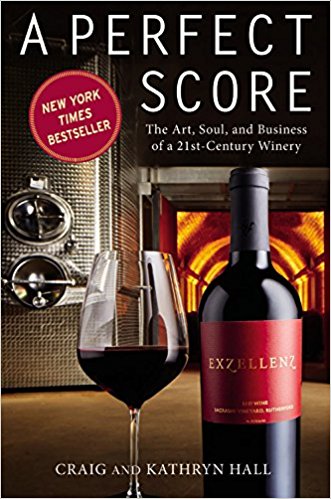 A Perfect Score: The Art, Soul, and Business of a 21st Century Winery Craig and Kathryn Hall (Center Street) $26.00 I have been trying to learn more about wine in recent years, but my budget and stubbornness insist that I stay at the budget bin, buying stuff that even those who aren’t fervent wine snobs cannot imagine. I have a few foodie friends and I’ve got pals who gush over the latest craft brew beers, too. It’s right and important, even, in God’s good world, to appreciate such gifts and I’m glad for their enthusiasms. (Read Capon’s chapter on the glories of the onion in Supper of the Lamb if you don’t believe me, or just the preface to Calvin Seerveld’s classic Rainbows for the Fallen World.) But, still, for me, I enjoy a lot of things vicariously – in the new creation there will be plenty of time to enjoy stuff unhindered – so reading a book about wine is, for many of us, delicious in its own way.
A Perfect Score: The Art, Soul, and Business of a 21st Century Winery Craig and Kathryn Hall (Center Street) $26.00 I have been trying to learn more about wine in recent years, but my budget and stubbornness insist that I stay at the budget bin, buying stuff that even those who aren’t fervent wine snobs cannot imagine. I have a few foodie friends and I’ve got pals who gush over the latest craft brew beers, too. It’s right and important, even, in God’s good world, to appreciate such gifts and I’m glad for their enthusiasms. (Read Capon’s chapter on the glories of the onion in Supper of the Lamb if you don’t believe me, or just the preface to Calvin Seerveld’s classic Rainbows for the Fallen World.) But, still, for me, I enjoy a lot of things vicariously – in the new creation there will be plenty of time to enjoy stuff unhindered – so reading a book about wine is, for many of us, delicious in its own way.
I know there are oodles of books about Napa Valley and French wine country trips and memoirs about wine-making. We raved about the significance of the important The Spirituality of Wine by Gisela Kreglinger with its marvelous foreword by Eugene Peterson (Eerdmans; $24.00) but, I’ll admit, as tasty as it was, it didn’t always glow on the page. This one is captivating, told with a light touch. Many reviewers talk about being on the edge of their seat as they learn how the Hall’s run their winery. As they write, “Our personalities and passions, along with those of our team, have dictated our decisions and shaped everything from the design of our wineries to the taste of the wine itself.” Granted there’s a bit about how their work represents “the intersection of art, nature, globalization, and technology” and there’s some discussion of state-of-the-art equipment. Still, this is a fine book about a husband and wife team who recount their twenty-year climb from amateur winemakers to recipients of an “exceedingly rare” perfect score from Robert Parker’s Wine Advocate. Nice.
 Books for Living Will Schwalbe(Knopf) $25.95 I announced this book about books and recommended it heartily when it first came out a half year ago, but I want to highlight it here, now, if only briefly. I want to say as clearly as I can that this will be loved by nearly any book lover, that it is a delight to read – a perfect shape and feeling making it even a delight to hold and page through, as we do with books we love and want to just dip into serendipitously. You may recall Schwalbe for the wonderful book he wrote about the books he read with his dying mother — both voracious readers — called The End of Your Life Book Club. We so loved that and it is worth owning. This one is somewhat of a companion volume with Will sharing stories from his life, his loved ones, people he knows (his mom shows up again on occasion) all woven through what are almost book reviews. I call him Will, by the way, because he has revealed much about his life in these essays and he feels like a friend.
Books for Living Will Schwalbe(Knopf) $25.95 I announced this book about books and recommended it heartily when it first came out a half year ago, but I want to highlight it here, now, if only briefly. I want to say as clearly as I can that this will be loved by nearly any book lover, that it is a delight to read – a perfect shape and feeling making it even a delight to hold and page through, as we do with books we love and want to just dip into serendipitously. You may recall Schwalbe for the wonderful book he wrote about the books he read with his dying mother — both voracious readers — called The End of Your Life Book Club. We so loved that and it is worth owning. This one is somewhat of a companion volume with Will sharing stories from his life, his loved ones, people he knows (his mom shows up again on occasion) all woven through what are almost book reviews. I call him Will, by the way, because he has revealed much about his life in these essays and he feels like a friend.
When Books for Living first came out I over-simplified it by saying it was a collection of book reviews, how various books can help one live well. It is that, I suppose, and each essay ruminates and revolves around a particular book. But while the wonderful Bird By Bird chapter does explain a bit of how Anne Lamotte came up with that marvelous line in her beloved book about writing, Will’s chapter strays from Bird quickly, touching down and nicely citing a number of other books by Lamotte, who he adores and commends.
Most chapters are lovely, beautifully rendered, anchored in a well told story that brings his life into conversation with the book and/or the author in question. From his passion for the characters in David Copperfield to the impact of E.B. White’s classic Stewart Little to a riveting piece about his coming of age in the gay community in the earliest days of the AIDS epidemic (and the book The Gifts of the Body) these chapters read like memoir mashed up with review. He is a sharp and open-hearted reader and could be an astute critic, but this isn’t academic literary criticism. These are stories about life, a good life in many ways, informed by books.
Each chapter of Books for Living has a one or two word subtitle, a bit of homage to classic self-help books, preceded by the book that will inform the advice subtly offered in that essay. For instance, his extraordinary telling of the YA book Wonder by R.J. Palacio has the subtitle “Choosing Kindness.” Gift from the Sea is followed by the simple “Recharging.” The chapter on Zen and the Art of Archery has as its subtitle “Mastering the Art of Reading” and the advice gleaned from Reading Lolita in Tehran is on “Choosing Your Life.” Interestingly, “Praying” is the theme of his reflections on Death Be Not Proud and he draws lovely insight about “Finding Friends” from The Little Prince.
I know it sounds extravagant to say that a few pages are “worth the price of the book” but I am not exaggerating to say that the long introduction on the importance and joys of reading, how we can learn and take great pleasure as well, is, indeed, worth the price of admission. For what it is worth, I am going to quote an extended page or two in a workshop I’m planning, and if you do any teaching or need to motivate yourself or others to be more intentional about making time for relaxed reading, these first 20 pages will be very useful.
This book is a pleasure and a joy and while I may not pick up every book he recommends, the way he tells how these books affected him and others is itself a lesson to absorb, and it very well introduce you to some important new authors. Most of these pieces are written with a straightforward, nice touch although a few are adamant. Will gets a bit preachy at the end, which I like, and it’s worth quoting:
Books remain on of the strongest bulwarks we have against tyranny – but only as long as people are free to read all different kinds of books, and only as long as they actually do so. The right to read whatever you want whenever you want is one of the fundamental rights that helps preserve all the other rights. It’s a right we need to guard with unwavering diligence. But it’s also a right we can guard with pleasure. Reading isn’t just a strike against narrowness, mind control, and domination. It’s one of the world’s great joys.
How ’bout that, Hearts & Minds friends and supporters?
Will Schwalbe continues:
How we live is no trivial matter. Racing around in a state of agitation and greed and envy isn’t just wasting our lives; it’s a symbol of much that is wrong with our world. And reading all different kinds of books is not simply reading all different kinds of books; it’s a way of becoming more fully human and humane.
When I read, I’m reminded to be more thoughtful about how I approach each day. And that’s not just important for living; it’s the least I can do for the dead.
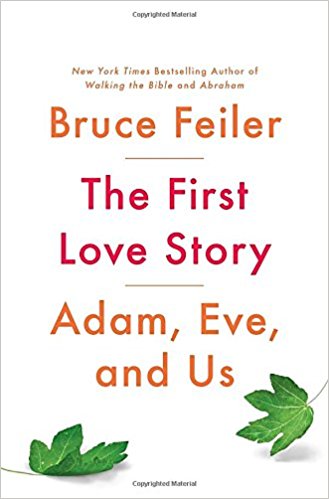 The First Love Story: Adam and Eve and Us Bruce Feiler (The Penguin Press)$28.00 I’ve already mentioned this national best-seller a time or two and I want to remind you that it is nearly the quintessential book of fun, informative, non-fiction. We don’t know where to put a book like this in the store – yes, it’s good for self-help type readers as it is about marriage and relationships, gender and sexuality. But yet, we don’t think it quite fits in with our marriage books and it isn’t a full-on memoir. He’s an upbeat reporter, intrepid, happily investigating his topic, exploring by travel, taking us along, offering tales and insight as he discovers insights from often unusual sources. And, yes, it is sort of a memoir, with Feiler chronicling his days traveling around the ancient Near East. (Who literally goes looking for Eden, except maybe archeologists and nut-jobs, for crying out loud – what a hoot!) And although it is about Adam and Eve, it isn’t a Scripture commentary, so it doesn’t go there on our shelves. Its nonfiction reporting, offering history and science and philosophy and Bible study and travelogue and storytelling and marriage advise along the way. This book is fun, and it is helpful. What a good book to take on vacation with just enough bold storytelling and just enough serious content, shared by a respected and talented writer. Creative non-fiction, fun summer reads, learning with a laugh. Get The First Love Story, and then backtrack and read other books by this wonderful, upbeat, educated author.
The First Love Story: Adam and Eve and Us Bruce Feiler (The Penguin Press)$28.00 I’ve already mentioned this national best-seller a time or two and I want to remind you that it is nearly the quintessential book of fun, informative, non-fiction. We don’t know where to put a book like this in the store – yes, it’s good for self-help type readers as it is about marriage and relationships, gender and sexuality. But yet, we don’t think it quite fits in with our marriage books and it isn’t a full-on memoir. He’s an upbeat reporter, intrepid, happily investigating his topic, exploring by travel, taking us along, offering tales and insight as he discovers insights from often unusual sources. And, yes, it is sort of a memoir, with Feiler chronicling his days traveling around the ancient Near East. (Who literally goes looking for Eden, except maybe archeologists and nut-jobs, for crying out loud – what a hoot!) And although it is about Adam and Eve, it isn’t a Scripture commentary, so it doesn’t go there on our shelves. Its nonfiction reporting, offering history and science and philosophy and Bible study and travelogue and storytelling and marriage advise along the way. This book is fun, and it is helpful. What a good book to take on vacation with just enough bold storytelling and just enough serious content, shared by a respected and talented writer. Creative non-fiction, fun summer reads, learning with a laugh. Get The First Love Story, and then backtrack and read other books by this wonderful, upbeat, educated author.
There are plenty of rave reviews of this substantive work, but the endorsements are peppered with words like wit, grace, wisdom, joy. James Martin, the very funny Jesuit scholar, says:
Mr. Feiler has the unique ability to introduce readers to the insights of art, history, and theology in a way that makes a seemingly hidebound topic come alive and the oldest Bible stories seem fresh, inspiring, even exciting.
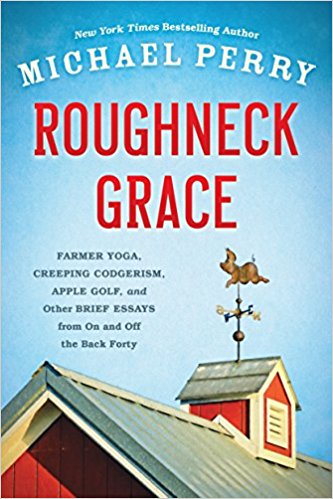 Roughneck Grace: Farmer Yoga, Creeping Codgerism, Apple Golf, and Other Brief Essays from On and Off the Back Forty Michael Perry (Wisconsin Historical Society Press) $18.95 I know I mentioned this before, but Beth, my wife and Heart & Minds partner, has declared this her favorite reading experience of the year -and, man, does she love her Fredrik Backman; she’s still talking about that man Ove and she finished Beartown in like a day. But she’s a big Michael Perry fan and I, too, want to chime in saying how much I admire this great, great writer. Almost everyone I know who gives Perry a try enjoys him, and his full-length nonfiction romps through rural life – Coop, Truck, Population 483, Meeting Tom. He is known for funny storytelling mixed with really poignant observations about life and times and things that matter most (including a nearly palpable sense of his being an earnestly good father, the kind of dad I admit I wish I had been.) This collection of brief essays from his Sunday Wisconsin State Journal column is a perfect introduction to Perry’s oddball look at life and his touching writing style. It would be a great book to take with you if your heading out this summer, or a good one to read a bit each night, perhaps outside on a lawn chair.
Roughneck Grace: Farmer Yoga, Creeping Codgerism, Apple Golf, and Other Brief Essays from On and Off the Back Forty Michael Perry (Wisconsin Historical Society Press) $18.95 I know I mentioned this before, but Beth, my wife and Heart & Minds partner, has declared this her favorite reading experience of the year -and, man, does she love her Fredrik Backman; she’s still talking about that man Ove and she finished Beartown in like a day. But she’s a big Michael Perry fan and I, too, want to chime in saying how much I admire this great, great writer. Almost everyone I know who gives Perry a try enjoys him, and his full-length nonfiction romps through rural life – Coop, Truck, Population 483, Meeting Tom. He is known for funny storytelling mixed with really poignant observations about life and times and things that matter most (including a nearly palpable sense of his being an earnestly good father, the kind of dad I admit I wish I had been.) This collection of brief essays from his Sunday Wisconsin State Journal column is a perfect introduction to Perry’s oddball look at life and his touching writing style. It would be a great book to take with you if your heading out this summer, or a good one to read a bit each night, perhaps outside on a lawn chair.
I want to say a couple of quick things about this marvelous book: it is wholesome in the very best sense; Perry is a good man, who cares about his neighbors and children and land and he does so not only with very good humor, but without being self-righteous or maudlin about it. I can hardly think of a more delightful writer, somebody who brings a smile for his big heart for his small place and the pleasure he takes in noticing stuff in his day to day world. What a joy that he can go on and on about whacking apples with a golf club and the different sorts of detritus or can write a whole column, actually several whole columns, on how cold it is in his parts. (Yeah, his parts.) I love this short essay genre, and Perry is a master, pleasant and interesting, drawing some kind of meaning from the mundane. For instance, he does one on lawn mowing (“Mower Maintenance”) that starts like this:
I am not your leading lawn guy. Don’t get me wrong – I admire a neat lawn, in very much the same way I admire a nicely knotted tie. Looks good, good for you for doing it, and I’ll be over here in my ratty old T-shirt.
So, he’s a roughneck slob, a real small town guy who writes about hunting and fixing trailers and the tire swing he made for his children. (And, I might add, it’s the best tire swing thing I’ve ever read.) He writes well about the glories of nature. His nature writing really is beautiful, but not in an Annie Dillard way, if you know what I mean; I adore his wordsmith in describing pheasants and spring melt and ordinary stuff like getting foolishly stuck in a chapter called “Mudded Up.” He talks about “brush-hogging the burdock and wild cucumber that are lately threatening to overtake our farm. They have become the kudzu of the North.”
His clever wordplay and cadence and how he often brings his ruminations back to an early trope or phrase strikes me as brilliant. How do writers have the ability to do this, tie a package together, connecting the dots like that? I so enjoy writers that are not deep in some fancy-pants literary way, but still have a way with words with something to say. Consider this, for instance, in his piece called “So Long Summer.” The whole bit works, but I loved how he writes “its shoulder to the sun” and how it ends up being about his daughter growing up.
And yet as our hemisphere enters the time of turning its shoulder to the sun, I am not impervious: On a cool autumn day when my elder daughter was four years old I found her sitting in her backyard rope swing, disconsolately sobbing. Between deep breaths she told me she was sad about the falling leaves. I said something about autumn bringing us new and pretty colors. This only refreshed her tears, and she exclaimed, “But I want summer to be here every day!”
Today she is a teenager taller than I and just got asked to homecoming. I couldn’t be happier for her…even as I wish summer could be here every day.
There’s some rock and roll stuff that goes on here – he knows a bit about alt-country and old Americana, too. He admits to taking “guilty delight” to having once written that “Johnny Paycheck is to Kenny Chesney as corn whiskey is to wine coolers” but then notes that “Mr. Chesney’s career did not waver in face of my wit.” (What a line!) Perry continues, with typical self-deprecation, “Should we ever meet I will apologize personally. Then we’ll rap out a nice set of ab crunches. If he wishes, I’ll hold his ankles.”
Perry is very funny, but not exactly a humorist (although, granted, his only novel was called The Jesus Cow about a calf born with a picture of Jesus on its hide.) He’s often out on book tours, doing readings in swanky places (well, in grange halls and county fairs, too, I suppose) so it isn’t all small town goofiness. I enjoy and admire this blend of personality and worldview and I, again, Beth and I both adore his well-honed craft, his writing abilities. Not a few of the pieces talk about his writing shed, his deadlines, doing readings, and the stuff that happens when one has a vocation of being a writer. Unless you don’t want to read about Fruit of the Loom tube socks or sheep hoofs whose claws had “overgrown and curled under like a bad Frito” I would highly recommend Roughneck Grace and anything else by Michael Perry. He’s got another Wisconsin Historical Society collection coming at the end of the summer, so get going on this now. You’ll want more, later, for sure.
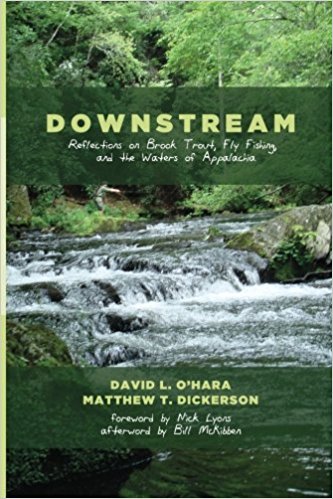 Downstream: Reflections on Brook Trout, Fly Fishing and the Waters of Appalachia David L. O’Hara & Matthew T. Dickerson (Cascade Books) $18.00 In creating this list of fun reads for summer, I didn’t mean to suggest they’d all be silly or funny. This one, for instance, is charming but wonderfully written, by two seriously Christian environmentalists, fishermen, and scholars. O’Hara is a professor of philosophy at Augustana College (he has written for the Chronicle of Higher Education, the late, great, Books & Culture, and the literary environmental journal, Orion.) Dickerson is a professor at Middlebury College and prolific as a writer of literary works about C.S. Lewis and Tolkien, a wonderful survey of epic fantasy (From Homer to Harry Potter) and a trilogy of his own creative fantasy. I say all this to assure you that this is thoughtful and mature, sophisticated, even, in vision and literary quality. But yet, at the end of the day, it is a set of narratives about fishing (including some wonderful pages about Central Pennsylvania, for those that know Spruce Creek and Bald Eagle Creek and Spring Creek near State College. There is an afterword, by the way, by their friend the nature writer and activist Bill McKibben who – although not a fisher himself – says:
Downstream: Reflections on Brook Trout, Fly Fishing and the Waters of Appalachia David L. O’Hara & Matthew T. Dickerson (Cascade Books) $18.00 In creating this list of fun reads for summer, I didn’t mean to suggest they’d all be silly or funny. This one, for instance, is charming but wonderfully written, by two seriously Christian environmentalists, fishermen, and scholars. O’Hara is a professor of philosophy at Augustana College (he has written for the Chronicle of Higher Education, the late, great, Books & Culture, and the literary environmental journal, Orion.) Dickerson is a professor at Middlebury College and prolific as a writer of literary works about C.S. Lewis and Tolkien, a wonderful survey of epic fantasy (From Homer to Harry Potter) and a trilogy of his own creative fantasy. I say all this to assure you that this is thoughtful and mature, sophisticated, even, in vision and literary quality. But yet, at the end of the day, it is a set of narratives about fishing (including some wonderful pages about Central Pennsylvania, for those that know Spruce Creek and Bald Eagle Creek and Spring Creek near State College. There is an afterword, by the way, by their friend the nature writer and activist Bill McKibben who – although not a fisher himself – says:
This gentle book is no activist’s tract. It’s better than that, by far. It bears witness to what we have right now, the beauty that surrounds all of us who live in the rural East. It bears witness to the stories of those places in the past, and to their possibilities for the future. The prose is calm, composed, and strong: appropriately, there’s a strong and deep current that runs through the book, a current of care. It swept me along, start to finish.
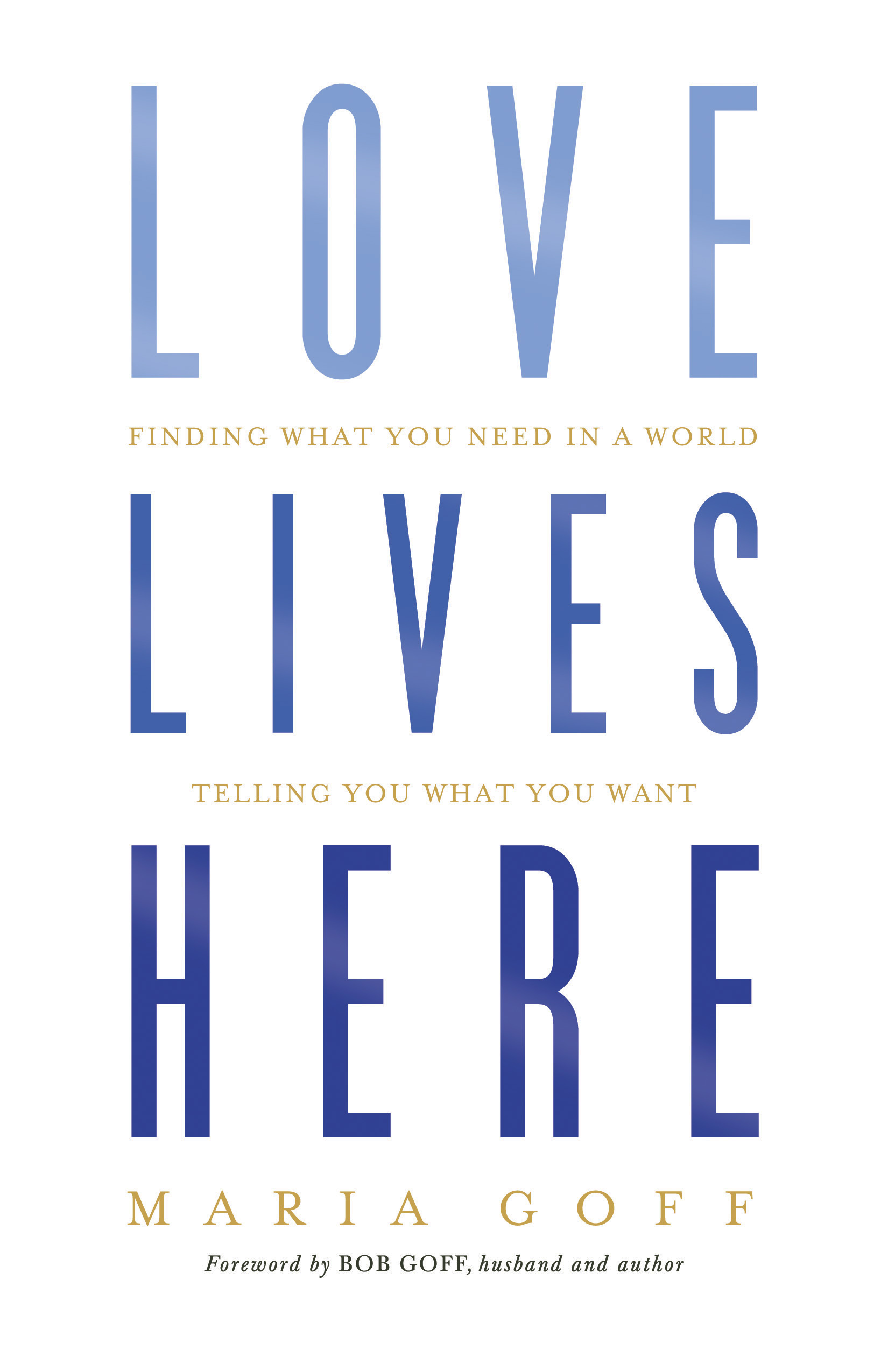 Love Lives Here: Finding What You Need in a World Telling You What You Want Maria Goff (B+H) $17.99 I hope you know Love Does by Bob Goff, a book that would go on this list in a heartbeat if I haven’t mentioned it so often before. Goff is fun, funny, inspiring, profound, even, even though his book is loaded with whimiscal antics and love-you-neighbor shenanigans. He mentions his Sweet Maria often in his books and talks, even though she rarely goes with him to wage peace in war zones or to start a school in Uganda or when he uses his high-powered lawyer skills to chase down child traffickers. She’s a ying to his yang, I suppose, and an introvert to his super, super extroverted outgoing style. She says Bob is “all gas and no break” and “his favorite number of people to be with is more.” Her, not so much. It even surprised me to hear she was writing a book.
Love Lives Here: Finding What You Need in a World Telling You What You Want Maria Goff (B+H) $17.99 I hope you know Love Does by Bob Goff, a book that would go on this list in a heartbeat if I haven’t mentioned it so often before. Goff is fun, funny, inspiring, profound, even, even though his book is loaded with whimiscal antics and love-you-neighbor shenanigans. He mentions his Sweet Maria often in his books and talks, even though she rarely goes with him to wage peace in war zones or to start a school in Uganda or when he uses his high-powered lawyer skills to chase down child traffickers. She’s a ying to his yang, I suppose, and an introvert to his super, super extroverted outgoing style. She says Bob is “all gas and no break” and “his favorite number of people to be with is more.” Her, not so much. It even surprised me to hear she was writing a book.
When Love Lives Here came I wanted to announce it promptly so gave it a good description after having only dipped in a bit, skimming a couple of pages. I quoted others who raved and said what they said. I noted nice things that were true, but I hadn’t really been captivated by it at that point.
Now that I’ve read it, I want to just shout — shout! — how much I enjoyed it, how good it truly is, and how much I like the gumption and style and freedom of this courageous wife and mom. She tells some remarkable stories, and while she always draws lessons from each — and they are lovely, nice, encouraging, empowering, brave lessons — her honesty about her life is what just blew me away.
This book deserves to be discussed and a review that does it justice would necessarily describe every chapter. Not a one is a let down, and several are very deeply moving.
And they are all fun. Man, does Sweet Maria have a load of wit. Reading these stories is a blast; the episodes are great. How could they not be, as Maria invites us into their extraordinary lives.
The first chapter left me stunned: I had not heard that their beloved Lodge in British Columbia that has served so many people as a get away and retreat center burned to the ground. How they coped with the loss and grief was so Goff, so real and raw and yet trusting in God and finding something to laugh about. This is a theme of Love Lives Here that created a life and home and community of love takes risks and it will not be easy. Just read what she learned when they bought their wedding ring from a guy who had just been shot; see how she balances an exuberant joy in living with a realism about hurts and pains and the baggage we all bring to our relationships, including her own insecurities. Maria tells early on in the book about her experience being in rehab for an eating disorder; she does not trivialize the trauma but does not dwell on it, either. She is about honoring our hurts and moving on, working hard to be real about our limits but always being guided by the Holy Spirit to become more like Jesus.
Being like Jesus; it’s that simple and that hard, living love. There’s a chapter about Bob proving to her that he had inherited an old gold mine. She explains a bit about the hot trip to the desolate territory where they found his little whole in the ground mine, and we learn a bit about gold mining. Miners often found gold in big veins of quartz. Follow the quartz and your find the gold. In other words, dig in for the long haul.
There are fun stories here — their first date almost ended in a stove fire on a boat, their second was rock climbing (even though Maria is scared of heights.) She talks about loud early mornings with their kids, likening it to the New York Stock Exchange and their colorful personalities (and has them each write a short contribution at the end which is nice.) There are tender bits about being who you are, the struggle to realize God loves us — she was held back after her fifth grade year due to a learning disability and wore orthopedic shoes, which didn’t help her self esteem. There were hard times growing up with a hard to get along with father. There are moments that will make you smile, and there are moments that might have you pondering your own life, as she is honest about the mess.
Love Lives Here is a great book to read straight through, or to dip into, reading each chapter by itself as you can. It feels to me like a summertime book, a great book to read and talk about and share. One of the chapters advises us to find good friends — okay, it’s a little more interesting than that, as it always is in their interesting life. Maybe this book will inspire you to do life well with others. It would make Maria happy, I’m sure, to hear that her stories brought a smile, and deepened your own love.
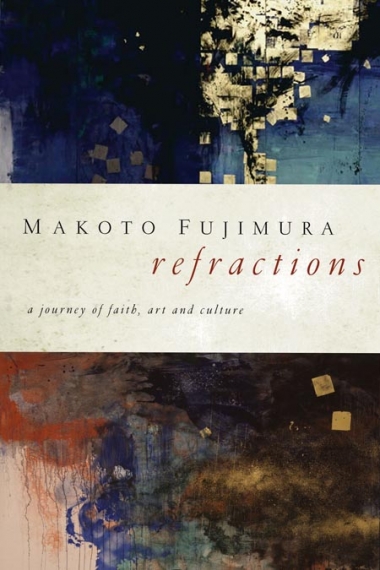 Refractions: A Journey of Faith, Art, and Culture Makoto Fujimura (NavPress) $24.99 Many of our friends now of our fondness for the art and the art advocacy of the esteemed Japanese-American abstract painter, Mako Fujimura. We have promoted his books over the years, including a wonderful small book called Soliloquies showing his art in comparison with reproductions of some previously un-shown works of George Rouault, his serious study of suffering in the Endo novel Silence (entitled Silence and Beauty) and his broad and wise manifesto of faith-based cultural renewal called Culture Care. This older book, though, is in ways lighter, more fun, more engaging than any of those – as good and wonderful and important as they truly are. This very handsome paperback book (it includes much of his early work, nicely reproduced on heavier glossy paper) is a set of almost 30 reflections, ruminations — “refractions” he calls them. Consider them a collection of essays or an anthology of his early writings about faith, culture, life, joy, sorrow, awe… Some were written after the 9-11 attack near his home in Manhattan, and through the displacement and grief of those months he helped organize some public spaces for art to be created and displayed, so there are some essays about that, heavy but glorious, about aesthetics and peace and suffering and hope. But other pieces are about films or novels or art shows or making good stuff for the common good; there is an essay on paper, a story about experiencing Christmas in Japan, a lovely refraction on Peter Pan, among other things.
Refractions: A Journey of Faith, Art, and Culture Makoto Fujimura (NavPress) $24.99 Many of our friends now of our fondness for the art and the art advocacy of the esteemed Japanese-American abstract painter, Mako Fujimura. We have promoted his books over the years, including a wonderful small book called Soliloquies showing his art in comparison with reproductions of some previously un-shown works of George Rouault, his serious study of suffering in the Endo novel Silence (entitled Silence and Beauty) and his broad and wise manifesto of faith-based cultural renewal called Culture Care. This older book, though, is in ways lighter, more fun, more engaging than any of those – as good and wonderful and important as they truly are. This very handsome paperback book (it includes much of his early work, nicely reproduced on heavier glossy paper) is a set of almost 30 reflections, ruminations — “refractions” he calls them. Consider them a collection of essays or an anthology of his early writings about faith, culture, life, joy, sorrow, awe… Some were written after the 9-11 attack near his home in Manhattan, and through the displacement and grief of those months he helped organize some public spaces for art to be created and displayed, so there are some essays about that, heavy but glorious, about aesthetics and peace and suffering and hope. But other pieces are about films or novels or art shows or making good stuff for the common good; there is an essay on paper, a story about experiencing Christmas in Japan, a lovely refraction on Peter Pan, among other things.
I so enjoy this and every so often get to show it to a customer and am reminded afresh what a lovely, wise, wonderful book it really is. Ian Morgan Cron calls it “elegantly penned” and Nancy Pearcy says “his translucent prose warrants close, meditative reading” while Jeremy Begbie calls these dispatches “at once bold and gracious.” As Rev. Susan Johnson of Hyde Park Union Church in Chicago writes of how it evidences Gods healing and grace and that “even in moments that seem to beg for closure, he pleases for a certain openness and wonder.” Openness and wonder – how’s that for a description of pleasurable, meaningful, fascinating, creative non-fiction. Highly recommended.
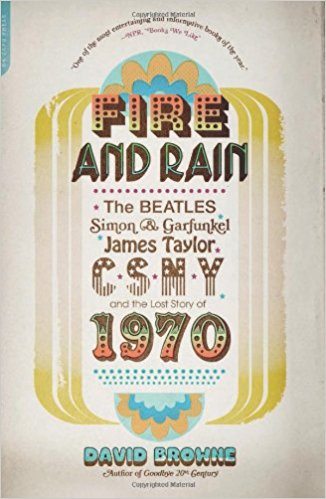 Fire and Rain: The Beatles, Simon and Garfunkel, James Taylor, CSNY and the Lost Story of 1970 David Browne (De Capo Press) $16.00 This wonderful book may not appeal to most of our readers, but if you have any interest in the late 1960s as they morphed into the early 70s, as seen through the most popular pop stars and the biggest-selling albums of that era, this book will hold your interest and bring loads of insight from the very first page. I lived through that era and this music truly is among my all-time favorites. Reading this was beyond fun, it was deeply meaningful and interesting and even though I knew every and artist and album mentioned, the studio musicians, even most of the producers, I learned so much about my one-time heroes. And, wow, there’s a lot to learn.
Fire and Rain: The Beatles, Simon and Garfunkel, James Taylor, CSNY and the Lost Story of 1970 David Browne (De Capo Press) $16.00 This wonderful book may not appeal to most of our readers, but if you have any interest in the late 1960s as they morphed into the early 70s, as seen through the most popular pop stars and the biggest-selling albums of that era, this book will hold your interest and bring loads of insight from the very first page. I lived through that era and this music truly is among my all-time favorites. Reading this was beyond fun, it was deeply meaningful and interesting and even though I knew every and artist and album mentioned, the studio musicians, even most of the producers, I learned so much about my one-time heroes. And, wow, there’s a lot to learn.
Think of it: the largest bands and entertainers the world had known at that point – The Beatles, Simon and Garfunkel, Crosby Still, Nash and Young – broke up that year. They each released defining albums (Let It Be, Bridge Over Troubled Water, Déjà vu — each created amidst drug abuse and interpersonal animosity and new sorts of recording possibilities. The break-ups of the groups gave rise to solo albums, records that remain perennial favorites. What a year which yielded solo work in 71– the first releases by John Lennon, by Paul McCartney, by Ringo, and of course Harrison’s three-album set, All Things Must Pass, not to mention the wonderful first album by Paul Simon and soon enough, the solo Neil Young release (After the Gold Rush followed by Harvest), the exquisite If Only I Could Remember My Name by David 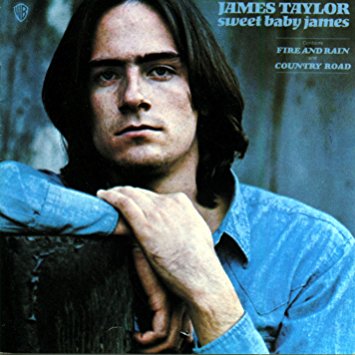 Crosby and Songs for Beginners by Graham Nash. And Stills, with that odd stuffed giraffe on the cover. In the background of all if this is, sometimes literally, (well, yes, Joni Mitchell) was none other than a rising star named James Taylor. Most of his fans know his first (unsuccessful) album was the first release on the Beatles own fated Apple Records; his drug and mental health problems plagued him even as he became the number one singer-songwriter in the world. Did you know that three or four other acts had covered “Fire and Rain” before his label released it as a single in February of 1970?
Crosby and Songs for Beginners by Graham Nash. And Stills, with that odd stuffed giraffe on the cover. In the background of all if this is, sometimes literally, (well, yes, Joni Mitchell) was none other than a rising star named James Taylor. Most of his fans know his first (unsuccessful) album was the first release on the Beatles own fated Apple Records; his drug and mental health problems plagued him even as he became the number one singer-songwriter in the world. Did you know that three or four other acts had covered “Fire and Rain” before his label released it as a single in February of 1970?
This book shifts back and forth as these world-class artists create their masterpieces, fall apart, get back together, fall apart, and release solo material that changed the face of popular culture. And the story is told in light of the big changes in society, the inevitable backdrop of 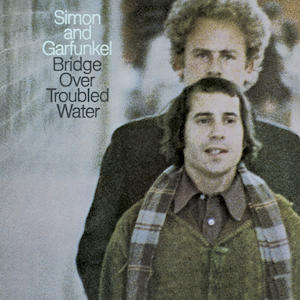 the rise of counterculture, anti-war activism, and back-to-nature communes. (Even Dylan went country with his Nashville Skyline album.) From the campus uprisings of 68 and 69, the nihilistic, terrorist bombings of The Weatherman, the horrific Manson murders, the massacre of students at Kent State by the National Guard, to the oddly calm campus culture in the fall of 1970, Browne, a long-time journalist for Rolling Stone, tells the story of the shift in music, too Did the rise of quieter singer-songwriters like Cat Stevens and Carol King and, of course, James Taylor, help tone down the uprisings and protests, or did the calmer times give rise to more introspective sounds? (Ahh, the old question about art and culture, shaping or reflecting the zeitgeist?)
the rise of counterculture, anti-war activism, and back-to-nature communes. (Even Dylan went country with his Nashville Skyline album.) From the campus uprisings of 68 and 69, the nihilistic, terrorist bombings of The Weatherman, the horrific Manson murders, the massacre of students at Kent State by the National Guard, to the oddly calm campus culture in the fall of 1970, Browne, a long-time journalist for Rolling Stone, tells the story of the shift in music, too Did the rise of quieter singer-songwriters like Cat Stevens and Carol King and, of course, James Taylor, help tone down the uprisings and protests, or did the calmer times give rise to more introspective sounds? (Ahh, the old question about art and culture, shaping or reflecting the zeitgeist?)
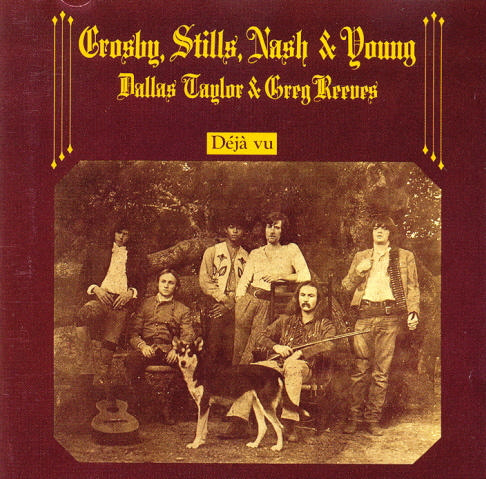
Those of us baby boomers who lived through these years surely know this music. You’ll get a kick out of hearing not only big picture stuff, but fabulous details (like the old fashioned, Civil War era cameras used for the cover of Déjà vu that had that black corky cover designed to resemble an old Bible or hymnbook, or the way Carole King and JT became friends, or which Beatles played on whose albums, usually without credit.) What an entertaining, informative book about important, wonderful, music.
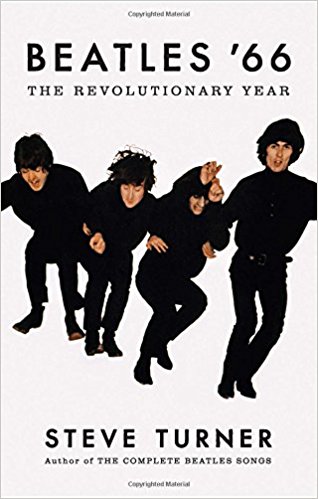 Beatles ’66: The Revolutionary Year Steve Turner (Ecco) $27.99 I can’t talk about that 1970s Fire and Rain book that features a lot about the Beatles breaking up and going solo without giving a shout out to the respected rock critic Steve Turner and his amazing book about the making of a “new” Beatles image, the year, he says, everything changed. As the subtitle insists, the most revolutionary year for the fab four was 1966. Turner knows the Beatles well, and has written mainstream, respected stuff on the backstories of their songs. He also has a fascinating book called The Gospel According to the Beatles and several great books on a Christian view of the arts, such as the recently re-issued, expanded Imagine: A Vision for Christians in the Arts and the very helpful PopCultured: Thinking Christianly about Style, Media and Entertainment.
Beatles ’66: The Revolutionary Year Steve Turner (Ecco) $27.99 I can’t talk about that 1970s Fire and Rain book that features a lot about the Beatles breaking up and going solo without giving a shout out to the respected rock critic Steve Turner and his amazing book about the making of a “new” Beatles image, the year, he says, everything changed. As the subtitle insists, the most revolutionary year for the fab four was 1966. Turner knows the Beatles well, and has written mainstream, respected stuff on the backstories of their songs. He also has a fascinating book called The Gospel According to the Beatles and several great books on a Christian view of the arts, such as the recently re-issued, expanded Imagine: A Vision for Christians in the Arts and the very helpful PopCultured: Thinking Christianly about Style, Media and Entertainment.
(That Steve spent some of his early Christian years being mentored at L’Abri should tell us much about his wholistic and culturally-engaged worldview.)
Anyway, this big book was hard for me to put down, even though the earliest Beatles work has never been that interesting to me. (I know, I’m sorry. Give me The White Album over Revolver any day, although reading Turner gave me a whole new interest in that period.) With extraordinary research and exceedingly rich insight about the culture – what books were being read, what artists were in which galleries, who was buying what fashions in the London scene, and why – Beatles ’66 unfolds as an amazing look at the rise of the Beat and Mod scene, and what quickly became the counterculture.
Before the back-to-the-land denim of CNS, the beards of The Band, and the long flowing dresses of the hippies of 1970, say, there was the frilly Edwardian fashion and psychedelic, colorful stuff of Magical Mystery Tour and Sgt. Pepper. But, as Turner painstakingly documents, their shift to those iconic looks and sounds and all it represented for our world wouldn’t have happened without the transitions of 1966, a year so important he insists on calling it “revolutionary.” So many things changed for them that year, from small details of how they recorded to the fact that it was the last time they performed live. (Revolver was, in fact, the first record they created not to be performed live but to be listened to as an album and it was signaled extraordinary new recording processes and the use of new instruments and arrangements.) Steve Turner’s Beatles ’66 book offers cultural studies, social history, music and fashion, and a hard-to-put-down, joyfully interesting study of that year in the lives of John, Paul, George, and Ringo. What a year, and what a book!
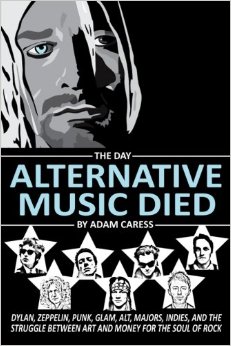 The Day Alternative Music Died: Dylan, Zeppelin, Punk, Glam, Alt, Majors, Indies, and the Struggle Between Art and Money for the Soul of Rock Adam Caress (New Troy Books) $16.99 I reviewed this a year or so ago when it first came out, and then we named it one of the best books of 2015. I cannot review it in full here so commend my sprawling BookNotes review to you, here. If you like rock music and want to explore how labels and commerce and cheap imitation of serious artist’s work – a pendulum swinging back and forth from this style to that – you will adore this wild ride through decades of rock music. Granted, it is centered in the question of what we used to call “alternative” – that Seattle grunge sound and all that is spawned – but it starts with the singers of the 1950s, the rise of rock journalism in the mid-60s, spends some time with Zooropa-era U2, and ends up almost 300 pages later with a candid reflection on indie rock in the digital age.
The Day Alternative Music Died: Dylan, Zeppelin, Punk, Glam, Alt, Majors, Indies, and the Struggle Between Art and Money for the Soul of Rock Adam Caress (New Troy Books) $16.99 I reviewed this a year or so ago when it first came out, and then we named it one of the best books of 2015. I cannot review it in full here so commend my sprawling BookNotes review to you, here. If you like rock music and want to explore how labels and commerce and cheap imitation of serious artist’s work – a pendulum swinging back and forth from this style to that – you will adore this wild ride through decades of rock music. Granted, it is centered in the question of what we used to call “alternative” – that Seattle grunge sound and all that is spawned – but it starts with the singers of the 1950s, the rise of rock journalism in the mid-60s, spends some time with Zooropa-era U2, and ends up almost 300 pages later with a candid reflection on indie rock in the digital age.
The Day Alternative Music Died and its hefty subtitle is a blast to read, a must-have for rock music aficionados. It is not only a great read for fans, but a must for anyone interested in the business of music. It happens to be very well written by a thoughtful cultural critic, a friend who teaches at Montreat College, an evangelical Christian college in North Carolina. It ought to be better known that it is as it is a very important book, fun as it is. Sven Birkerts, eloquent author of the acclaimed Gutenberg Elegies, says it is “chillingly persuasive. A carefully wrought and necessary book.” Enjoy.
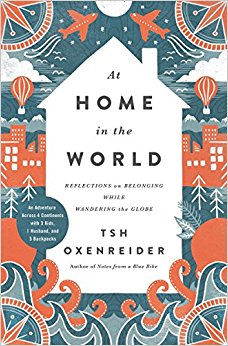 At Home in the World: Reflections on Belonging While Wandering Around the Globe Tsh Oxenreider (Nelson) $22.99 The subtitle is “And Adventure Across 4 Continents with 3 Kids, 1 Husband, and 5 Backpacks.” You know how I wrote above how I don’t buy fancy wine, but enjoyed that book about winemaking? Ditto with this: I don’t travel, let alone with backpacks and kids, but I so enjoy books that take us vicariously on these remarkable journeys. This is a handsome, wonderfully-crafted, generous, and thought-provoking story. Shauna Niequist – no slouch of a traveler or writer herself – says that At Home in the World is “A beautiful reminder of how travel shapes us, how beautiful the world is, and how parenting doesn’t need to mean the end of adventuring.” Jefferson Bethke wisely says, “This isn’t a stereotypical travel memoir about ‘finding yourself’ – it’s about a family that adventures because they already have.” It’s a really good read, perfect for your summer days, especially if you don’t get to go on such wild adventures. Highly recommended, with pleasure.
At Home in the World: Reflections on Belonging While Wandering Around the Globe Tsh Oxenreider (Nelson) $22.99 The subtitle is “And Adventure Across 4 Continents with 3 Kids, 1 Husband, and 5 Backpacks.” You know how I wrote above how I don’t buy fancy wine, but enjoyed that book about winemaking? Ditto with this: I don’t travel, let alone with backpacks and kids, but I so enjoy books that take us vicariously on these remarkable journeys. This is a handsome, wonderfully-crafted, generous, and thought-provoking story. Shauna Niequist – no slouch of a traveler or writer herself – says that At Home in the World is “A beautiful reminder of how travel shapes us, how beautiful the world is, and how parenting doesn’t need to mean the end of adventuring.” Jefferson Bethke wisely says, “This isn’t a stereotypical travel memoir about ‘finding yourself’ – it’s about a family that adventures because they already have.” It’s a really good read, perfect for your summer days, especially if you don’t get to go on such wild adventures. Highly recommended, with pleasure.
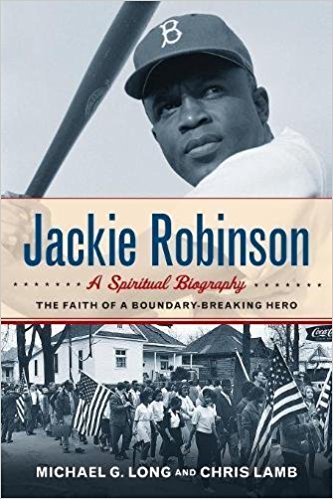
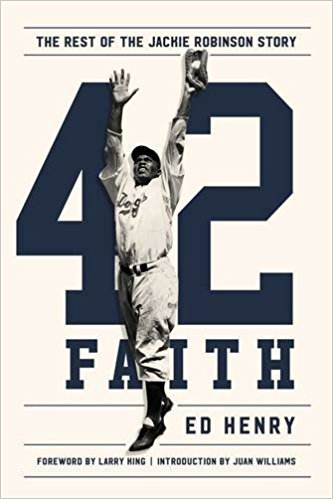 42 Faith: The Rest of the Jackie Robinson Story Ed Henry (Nelson) $24.99 and
42 Faith: The Rest of the Jackie Robinson Story Ed Henry (Nelson) $24.99 and
Jackie Robinson: A Spiritual Biography: The Faith of a Boundary-Breaking Hero Michael Long & Chris Lamb (WJK) $17.00
How can I invite you to some summer pleasure reading without naming something about baseball? Well, this is a big year to recall Jackie Robinson, and in keeping with this BookNotes theme of pleasurable words with good content, these are both extraordinary volumes, full of stories and information, background that you most likely will enjoy learning about. It I hard to explain which of these is better – it’s a toss-up, really – although I previously announced the Long & Lamb one, in part because it focuses more on the progressive faith that inspired Robinson (and others that make appearances, from Martin Luther King on) to be agents of desegregation and social justice. I think we sometimes forget the hard, hard work that goes into radical experiments for social progress and Long and Lamb (who have published a previous book on the letters of Jackie Robinson called First Class Citizenship: The Civil Rights Letters of Jackie Robinson) know this advocacy work well. They are both scholars as well as huge fans and have researched racial issues in American baseball and have both written widely; in fact Ed Henry draws on Chris Lamb’s seminal work, Blackout about Jackie Robinsons first Spring training. So, I’ve pushed the “spiritual biography” for promoting his radical “boundary-breaking.”
However, the Ed Henry 42 book captured me from the first page. The author is himself a journalist (and the book opens with an admirable conversation he has with President Obama, with the President asking Henry to relay a message to Jackie Robinson’s wife, who was still alive, and who Henry was going to be visiting.) Maybe that is part of the difference between these two biographies: Ed Henry allows his own story to enter into the book as he tells of visiting this person or reports on the trip to that stadium or as he explains how he felt meeting this old-timer or interviewing that one. Clearly, both are excellently researched, and both draw upon little known papers, including a manuscript by Jackie Robinson himself that was never published. Both are really informative, well written, captivating, especially if you care about either race relations during the civil rights era or Christian faith or baseball.
Maybe I’d say this: 42 Faith is the work of an expert communicator, a modern-day TV journalist, and carries a foreword by Larry King (who interviewed the great Jackie Robinson more than once) and a powerful forward by Juan Williams. Blurbs on the back include raves from Jim Brown and New York Times bestseller Brad Thor. Jackie Robinson: A Spiritual Biography carries endorsements on the back by preacher and activist James Forbes, investigative journalist and cultural critic Tom Krattenmaker, and the important Lee Lowenfish who wrote one of the definitive biographies of Branch Rickey. Both of these books are a treat, both are fun to read, and both are important. Maybe 42 Faith, a sturdy hardback, is the one to start with. But please, please, don’t miss the more intense, important work by Long and Lamb.
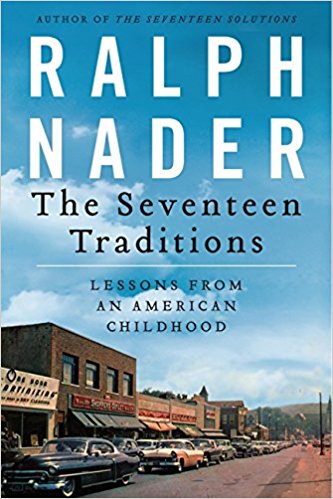 The Seventeen Traditions: Lessons from an American Childhood Ralph Nader (Harper) $13.99 The politicos among us might know Nader’s manifesto, The Seventeen Solutions. You surely know Nader as a consumer activist, a liberal-leaning populist, a leader cited by The Atlantic as one of the hundred most influential figures in American history. This is part memoir, part civics lesson, part a reminiscence of when families taught stuff like the tradition of listening, the tradition of charity, the tradition of civics, work, patriotism, simple enjoyment. Such family traditions, Nader says, “challenge the notion that the fads, technologies, how-to manuals, and addictions of modern life have somehow taken the place of the time-tested wisdom fashioned in the crucibles of earlier generations.”
The Seventeen Traditions: Lessons from an American Childhood Ralph Nader (Harper) $13.99 The politicos among us might know Nader’s manifesto, The Seventeen Solutions. You surely know Nader as a consumer activist, a liberal-leaning populist, a leader cited by The Atlantic as one of the hundred most influential figures in American history. This is part memoir, part civics lesson, part a reminiscence of when families taught stuff like the tradition of listening, the tradition of charity, the tradition of civics, work, patriotism, simple enjoyment. Such family traditions, Nader says, “challenge the notion that the fads, technologies, how-to manuals, and addictions of modern life have somehow taken the place of the time-tested wisdom fashioned in the crucibles of earlier generations.”
It is a delightful read, a perfect summer dip into older ways – ways that we need today, perhaps now more than ever. Called “warmly human,” The Seventeen Traditions is a surprising book, highly recommended.
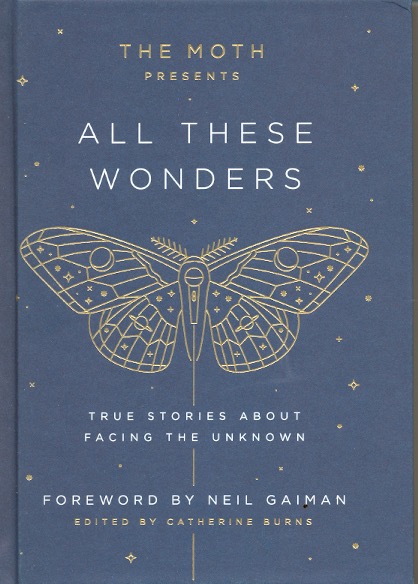 The Moth Presents: All These Wonders: True Stories About Facing the Unknown Foreword by Neil Gaiman (Crown Archtype) $25.00 I suppose you have heard of The Moth Radio Hour, put together by Atlantic Public Media. It is simply a cultural phenomenon, a modern-day storytelling festival on public radio. All These Wonders presents forty-five unforgettable true stories about risk, courage, and facing the unknown, drawn from “the best ever told on (The Moth’s) stages.” As it says on the back cover, these talks have been “adapted to the page to preserve the raw energy of live storytelling.” These stories feature voices familiar and new, speaking with pathos and humor, bravery and a touch of weirdness. When we wanted to list fun books for summer, I knew I wanted to highlight this – truth sometimes is stranger than fiction, and honest testimonials of human courage can sometimes be the most important things we can enjoy taking in.
The Moth Presents: All These Wonders: True Stories About Facing the Unknown Foreword by Neil Gaiman (Crown Archtype) $25.00 I suppose you have heard of The Moth Radio Hour, put together by Atlantic Public Media. It is simply a cultural phenomenon, a modern-day storytelling festival on public radio. All These Wonders presents forty-five unforgettable true stories about risk, courage, and facing the unknown, drawn from “the best ever told on (The Moth’s) stages.” As it says on the back cover, these talks have been “adapted to the page to preserve the raw energy of live storytelling.” These stories feature voices familiar and new, speaking with pathos and humor, bravery and a touch of weirdness. When we wanted to list fun books for summer, I knew I wanted to highlight this – truth sometimes is stranger than fiction, and honest testimonials of human courage can sometimes be the most important things we can enjoy taking in.
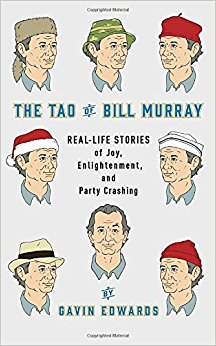 The Tao of Bill Murray: Real Life Stories of Joy, Enlightenment, and Party Crashing Gavin Edwards (Random House) $26.00 What an odd book. As Danny Rubin, screen writer of Groundhog Day says, “Reading The Tao of Bill Murray is like spending time with Bill, but probably safer.” No one will ever believer you” is the famous line Bill Murray says when he shows up at somebody’s wedding reception or hospital room or pickup basketball game. The famous actor’s adventure off screen are, for some, as entertaining as his movies, and his antics rival the most popular of popular culture. Is there some plan behind all this, some point, something earnest and real? This book insists that it is “more than just a collection of wacky anecdotes.” It puts the actor’s public clowning around into a larger context. It has plenty of celebrity gossip and movie-set stories, but it is also a “sideways mix of comedy and philosophy.” I’m not endorsing Murray’s behavior, let alone his philosophy of life, whatever it is. But this is a fun book full of surprises and maybe even some insight. Here’s what I wonder: what would it be like if Bob Goff, author of Love Does and popular storyteller and advocate of whimsical escapades for Christ ever met Bill Murray. Who would surprise whom? Ha.
The Tao of Bill Murray: Real Life Stories of Joy, Enlightenment, and Party Crashing Gavin Edwards (Random House) $26.00 What an odd book. As Danny Rubin, screen writer of Groundhog Day says, “Reading The Tao of Bill Murray is like spending time with Bill, but probably safer.” No one will ever believer you” is the famous line Bill Murray says when he shows up at somebody’s wedding reception or hospital room or pickup basketball game. The famous actor’s adventure off screen are, for some, as entertaining as his movies, and his antics rival the most popular of popular culture. Is there some plan behind all this, some point, something earnest and real? This book insists that it is “more than just a collection of wacky anecdotes.” It puts the actor’s public clowning around into a larger context. It has plenty of celebrity gossip and movie-set stories, but it is also a “sideways mix of comedy and philosophy.” I’m not endorsing Murray’s behavior, let alone his philosophy of life, whatever it is. But this is a fun book full of surprises and maybe even some insight. Here’s what I wonder: what would it be like if Bob Goff, author of Love Does and popular storyteller and advocate of whimsical escapades for Christ ever met Bill Murray. Who would surprise whom? Ha.
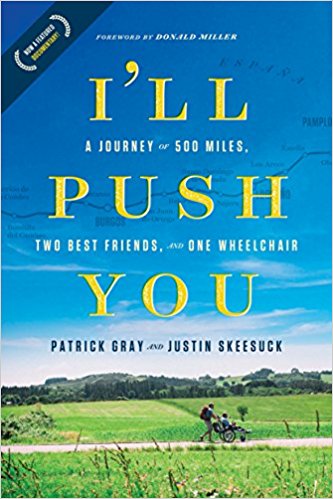 I’ll Push You: A Journey of 500 Miles, Two Best Friends, and One Wheelchair Patrick Gray & Justin Skeesuck (Tyndale) $15.99 I can’t wait to read this – maybe I’ll tell you more later in the year once I do. But I’m telling you, it looks just fantastic. A trusted friend inside its large publishing house assured me that it was his favorite book of the many they’ve released this season. There’s a documentary about the guys, too, that got some buzz at a few festivals, I’m told. It’s said to be “full of love, humor and faith” which sounds, I know, a bit tame. But I’m telling you now: this is a book about two life-long buddies, one now in a wheelchair, who go on a spiritual pilgrimage on the legendary (and difficult, I’m told) Camino de Santiago spiritual pilgrimage through the rough terrain of northern Spain. There must be a dozen books on the Camino, and the trail and the pilgrimage was made more popular by the wonderful movie with Martin Sheen called The Walk. This new book looks like a lovely and even powerful read, with pictures, a discussion guide, and a website full of extra content. Learn more about it here. The foreword is by Donald Miller, who says, after reflecting on his own love of stories and his studies about what make good stories work,
I’ll Push You: A Journey of 500 Miles, Two Best Friends, and One Wheelchair Patrick Gray & Justin Skeesuck (Tyndale) $15.99 I can’t wait to read this – maybe I’ll tell you more later in the year once I do. But I’m telling you, it looks just fantastic. A trusted friend inside its large publishing house assured me that it was his favorite book of the many they’ve released this season. There’s a documentary about the guys, too, that got some buzz at a few festivals, I’m told. It’s said to be “full of love, humor and faith” which sounds, I know, a bit tame. But I’m telling you now: this is a book about two life-long buddies, one now in a wheelchair, who go on a spiritual pilgrimage on the legendary (and difficult, I’m told) Camino de Santiago spiritual pilgrimage through the rough terrain of northern Spain. There must be a dozen books on the Camino, and the trail and the pilgrimage was made more popular by the wonderful movie with Martin Sheen called The Walk. This new book looks like a lovely and even powerful read, with pictures, a discussion guide, and a website full of extra content. Learn more about it here. The foreword is by Donald Miller, who says, after reflecting on his own love of stories and his studies about what make good stories work,
Rarely have I encountered such a story lived out in the everyday, where the hero – or in this case, heroes – could easily be you and me, ordinary people choosing to embrace an extraordinary life.
Well, I don’t know about that, since I can’t ever imagine myself doing such a thing. (I’ve pushed my share of wheelchairs through rough terrain, by the way, thanks to the opportunity for shenanigans at the Easter Seal Society’s now-shuttered Camp Harmony Hall.) But, whether we could do this thing or not, these guys really did. And that’s gotta be a blast to read about, an inspiring and fun story. As Miller says, noticing less about the arduous adventure, but the intimacy of true friendship and community,
They show us the redeeming power that exists in giving others the opportunity to love all of who we are, in spite of our flaws and imperfections… Be careful! When you choose to read this incredible testament of life, friendship, and faith, you will be challenged and will begin to look for those adventures that are already part of your life, the ones you haven’t embraced.
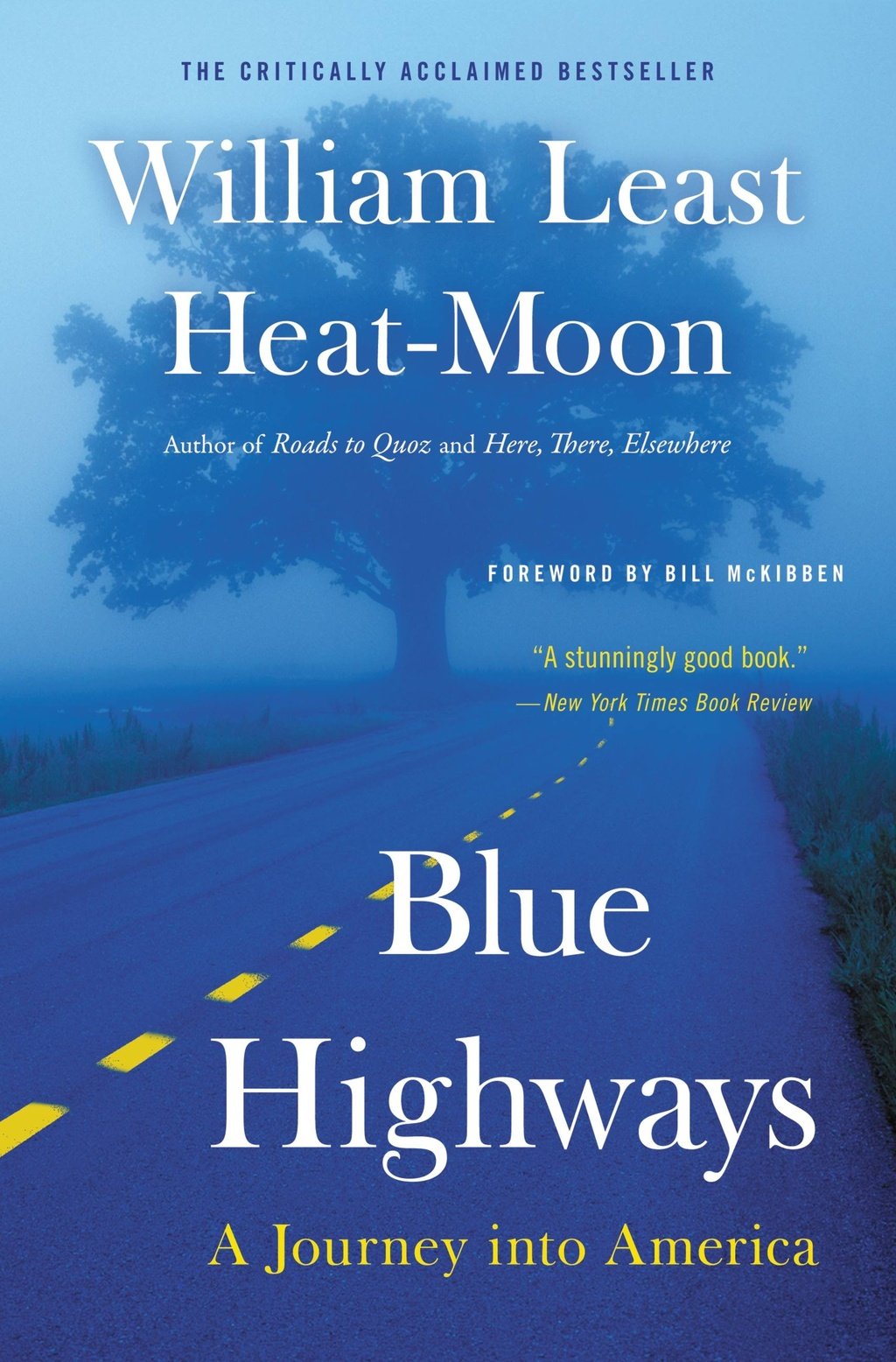 Blue Highways: A Journey to America William Least Heat-Moon (Back Bay Books) $16.00 This book was a huge bestseller when it was released in the early 1980s, and we so enjoyed stocking it then. Back then, as now, folks are sometimes surprised to see books that aren’t on Christian publishing houses or aren’t “religious” on the shelves of a Christian bookstore. This was a book that we’d tell folks about for the sheer joy of it, the profundity of the journey, the great writing. It is considered a masterpiece of American travel writing; it is an exploration of backroads. Annie Dillard says, “Heat-Moon is a witty, generous, sophisticated, and democratic observer. His modesty, kindly humor, and his uncanny gift of catching good people at good moments make Blue Highways a joy to read.”
Blue Highways: A Journey to America William Least Heat-Moon (Back Bay Books) $16.00 This book was a huge bestseller when it was released in the early 1980s, and we so enjoyed stocking it then. Back then, as now, folks are sometimes surprised to see books that aren’t on Christian publishing houses or aren’t “religious” on the shelves of a Christian bookstore. This was a book that we’d tell folks about for the sheer joy of it, the profundity of the journey, the great writing. It is considered a masterpiece of American travel writing; it is an exploration of backroads. Annie Dillard says, “Heat-Moon is a witty, generous, sophisticated, and democratic observer. His modesty, kindly humor, and his uncanny gift of catching good people at good moments make Blue Highways a joy to read.”
And, local friends, catch this Heat-Moon line, describing his journey to, “those little towns that get on the map – if they get on at all – only because some cartographer has a blank space to fill: Remote, Oregon; Simplicity, Virginia, New Freedom, Pennsylvania; New Hope Tennessee; Why, Arizona; Whynot, Mississippi.”
A group of pastors that do a book club retreat each year are reading this together this fall, which reminded me how much we enjoyed selling it. The newer edition has a nice foreword by Bill McKibben who says it is a book “that makes writers want to weep.” Even Walker Percy had an endorsement.
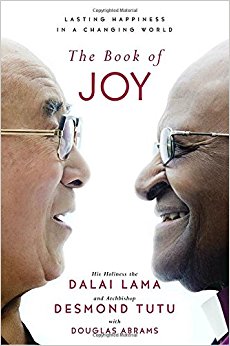
 The Book of Joy: Lasting Happiness in a Changing World the Dalai Lama & Desmond Tutu (Avery) $26.00
The Book of Joy: Lasting Happiness in a Changing World the Dalai Lama & Desmond Tutu (Avery) $26.00
Wow, His holiness and the Archbishop on joy – what an idea for an interfaith book! Both men are known for their overall happiness and fun, spry, spirits. I haven’t read this yet, but I can’t lie – I’ve smiled every time I’ve turned it over to peek at the back cover of them dancing. You have to love that.
The first page says this:
To celebrate one of our special birthdays, we met for a week in Dharamsala to enjoy our friendship and to create something that we hope will be a birthday gift for others. There is perhaps nothing more joyous than birth, and yet so much of life is spent in sadness, stress, and suffering. We hope this small book will be an invitation to more joy and more happiness.
They insist that “no dark fate” determines our future. The remind us that lasting happiness cannot be found in pursuit of any goal or achievement, but in the human mind and heart.
The book itself is co-authored by Douglas Abrhams, a legendary editor, who interviewed the two throughout their week together, and then wove together the stories and interviews that he drew out of them. He knows and understands them well.
He writes,
During the week their fingers were often wagging at each other teasingly, moments before their hand were clasped together affectionately. During our first lunch the Archbishop told the story of a talk they were giving together. As they were getting ready to walk on stage, the Dalai Lama – the world’s icon of compassion and peace – pretended to choke his spiritual older brother. The Archbishop turned to the Dalai Lama and said, “Hey, the cameras are on us, act like a holy man.”
Yep, even holy men have to fool around, and then have to determine to act like holy men. Can we act up, learn to be real and fun and people of joy, for real, by living into it? This hoot of a book can help. Enjoy!
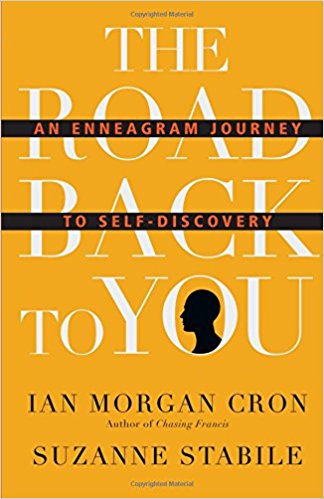 The Road Back to You: An Enneagram Journey to Self-Discovery Ian Cron & Suzanne Stabile (IVP) $24.00 As I was creating this list of fun non-fiction, making a case that learning can be uplifting and that we can read stuff for the sheer fun of it, but also be inspired along the way, I right away knew I wanted to include this. Yes, it is about the enneagram, so you might think it is a nearly tedious methodology to practice some self-discernment, being coming more self-aware about your deepest motivations (perhaps even drawing from your deepest hurts.) And you would be right about the self-awareness stuff, but it isn’t tedious at all. Yes, this could be described as ancient psychology meeting contemplative spirituality. Yes, it sounds a little weird if you aren’t used to it. But trust me: this makes the Meyers-Briggs tests seem dry and mechanical by comparison. In the hands of these two very clever writers, this topic comes alive. The Road Back to You is a ton of fun, offers lots of healthy insight and a bunch of stories. A whole lot of stories. Some of the stories are funny, a few are very touching, and a lot of them will help you know yourself more accurately and live better, with greater centeredness and, I suspect, a greater joy. It’s not about joy, per say, but it offers a window into knowing yourself in a way that sure is interesting. It’s a curiously popular book, in part because it is a fun read. Check it out.
The Road Back to You: An Enneagram Journey to Self-Discovery Ian Cron & Suzanne Stabile (IVP) $24.00 As I was creating this list of fun non-fiction, making a case that learning can be uplifting and that we can read stuff for the sheer fun of it, but also be inspired along the way, I right away knew I wanted to include this. Yes, it is about the enneagram, so you might think it is a nearly tedious methodology to practice some self-discernment, being coming more self-aware about your deepest motivations (perhaps even drawing from your deepest hurts.) And you would be right about the self-awareness stuff, but it isn’t tedious at all. Yes, this could be described as ancient psychology meeting contemplative spirituality. Yes, it sounds a little weird if you aren’t used to it. But trust me: this makes the Meyers-Briggs tests seem dry and mechanical by comparison. In the hands of these two very clever writers, this topic comes alive. The Road Back to You is a ton of fun, offers lots of healthy insight and a bunch of stories. A whole lot of stories. Some of the stories are funny, a few are very touching, and a lot of them will help you know yourself more accurately and live better, with greater centeredness and, I suspect, a greater joy. It’s not about joy, per say, but it offers a window into knowing yourself in a way that sure is interesting. It’s a curiously popular book, in part because it is a fun read. Check it out.
By the way, there is a participants workbook for Road Back… that you can get to go along with it; we often don’t promote extra books but in this case, at just $9.00, the study guide is a very wise investment. Highly recommended.
BookNotes
DISCOUNT
ANY ITEM MENTIONED
20% off
order here
takes you to the secure Hearts & Minds order form page
just tell us what you want
inquire here
if you have questions or need more information
just ask us what you want to know
Hearts & Minds 234 East Main Street Dallastown, PA 17313
read@heartsandmindsbooks.com
717-246-3333
